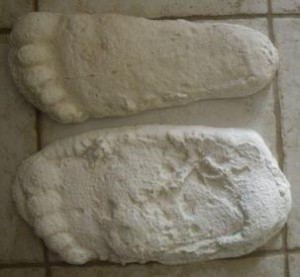
March 22, 2012
Occasionally, we should pause to re-review worthwhile contributions to the scientific literature that deal with Bigfoot and Sasquatch. In 2007, Jeff Meldrum, Ph. D., published one such paper. It was entitled “Ichnotaxonomy of Giant Hominid Tracks in North America,” and dealt with his understanding of the patterns being seen among Sasquatch and Bigfoot tracks, prints, and to a lesser extent, trackways.

Abstract—Large bipedal hominoid footprints, commonly attributed to Bigfoot or sasquatch, continue to be discovered and documented, occasionally in correlation with eyewitness sightings, and rarely in concert with photographic record of the trackmaker (gen. et sp. indet.). One of the best-documented instances occurred in 1967, when Roger Patterson and Bob Gimlin filmed an over two meter tall upright striding hominoid figure, at the site of Bluff Creek, in Del Norte County, California, and cast a right and left pair of exceptionally clear footprints in firm moist sand. Additional footprints were filmed, photographed, and cast by multiple witnesses. Molds and casts of a series of these are reposited at the National Museum of Natural History, Smithsonian Institution, while ten original casts are among the Titmus Collection at the Willow Creek – China Flats Museum, Humboldt County, California. These casts have been 3D-scanned and archived as part of a footprint virtualization project and scan images are accessible on-line through the Idaho Museum of Natural History. The initial pair, originally cast by Patterson, and the remaining casts made by Titmus, are designated the holotype of a novel ichnogenus and ichnospecies describing these plantigrade pentadactyl bipedal primate footprints – Anthropoidipes ameriborealis (“North American ape foot”). The footprints imply a primitively flat, flexible foot lacking a stiff longitudinal arch, combined with a derived, non-divergent medial digit.
Download the paper here: Ichnotaxonomy of Giant Hominid Tracks in North America




About Loren Coleman
Loren Coleman is one of the world’s leading cryptozoologists, some say “the” leading living cryptozoologist. Certainly, he is acknowledged as the current living American researcher and writer who has most popularized cryptozoology in the late 20th and early 21st centuries.
Starting his fieldwork and investigations in 1960, after traveling and trekking extensively in pursuit of cryptozoological mysteries, Coleman began writing to share his experiences in 1969. An honorary member of Ivan T. Sanderson’s Society for the Investigation of the Unexplained in the 1970s, Coleman has been bestowed with similar honorary memberships of the North Idaho College Cryptozoology Club in 1983, and in subsequent years, that of the British Columbia Scientific Cryptozoology Club, CryptoSafari International, and other international organizations. He was also a Life Member and Benefactor of the International Society of Cryptozoology (now-defunct).
Loren Coleman’s daily blog, as a member of the Cryptomundo Team, served as an ongoing avenue of communication for the ever-growing body of cryptozoo news from 2005 through 2013. He returned as an infrequent contributor beginning Halloween week of 2015.
Coleman is the founder in 2003, and current director of the International Cryptozoology Museum in Portland, Maine.
Filed under Artifacts, Bigfoot, CryptoZoo News, Evidence, Expedition Reports, Footprint Evidence, Forensic Science, Men in Cryptozoology, Sasquatch